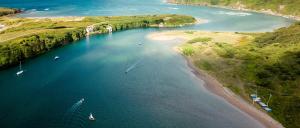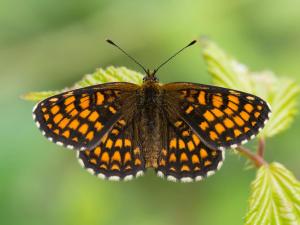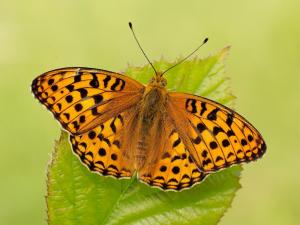
Grants
Landscape Regeneration
West Devon Butterfly Habitat
£25,000 awarded
This exciting project has been sponsored by a DEF supporter to showcase best practice creation, restoration, and optimisation of butterfly habitats on three West Devon sites – for the benefit of multiple native plant, insect, bird, and mammal species.
In particular, two of the sites have potential to be of benefit to two of the UK’s rarest butterfly species, the Heath Fritillary and High Brown Fritillary .
The project will take place over a period of 3-5 years, endeavouring to increase populations of rare and threatened butterfly species. The work will also increase overall biodiversity in the local area.
The Heath Fritillary butterfly (pictured below left), is nicknamed ‘The Woodman’s Follower’ because it thrives in the sunny, sheltered habitats that spring up in newly coppiced or felled woodland. Its caterpillars love to eat wildflowers such as Common Cow-wheat, Ribwort Plantain, and Germander Speedwell.
Sadly, this beautiful, dusky coloured butterfly is now one of Britain’s rarest, highly-threatened butterflies, and it would very likely be extinct in the UK if there had not been concerted conservation efforts. Populations are now restricted to a few woodlands in Cornwall, Devon, Kent, Essex and Exmoor.
The High Brown Fritillary (pictured below right) has also suffered dramatic declines in population in recent years and is one of the UK’s most threatened butterflies. It is a large butterfly usually spotted flying over the tops of bracken or low vegetation in woodland clearings, visiting flowers such as thistles and bramble. The High Brown Fritillary caterpillar requires Common Dog-violet as a food source.
Once widespread across England and Wales, the High Brown Fritillary is now reduced to just four breeding sites where conservationists are working to save it from extinction.
DEF’s West Devon Butterfly Habitat Restoration project has no guarantee of success due to factors outside of our control (such as climate change) but it gives these butterflies a chance that they would not have otherwise.
An increase in caterpillar and butterfly numbers is our desired outcome, but learnings are also very valid. We see this is as an opportunity to channel funds into a project that would be unlikely to be prioritised without DEF’s support, to give the Heath Fritillary and High Brown Fritillary a chance in West Devon.
Partnering with Natural England, Butterfly Conservation, Walreddon Estates, the Forestry Commission, and independent conservationists we will work to create the ideal habitat and restore the caterpillar food sources, before then attempting a reintroduction of especially bred adult butterflies to the area, with the hope of establishing a robust population.
We will share the learnings with the hope of helping more projects looking to save threatened populations.
Images courtesy of Butterfly Conservation, Bob Eade (left) and Iain Leach (right) and Tamás Nestor (title image).


